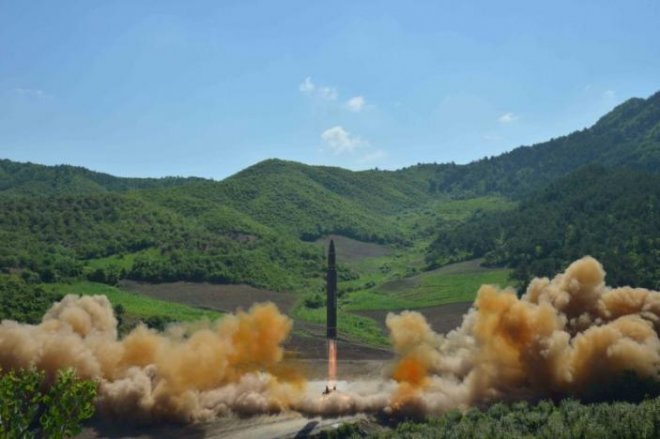
South Korean and Japanese officials said that North Korea fired a missile on Friday that flew over Japan's northern Hokkaido far out into the Pacific Ocean. This latest launch has further fueled up the tensions that rose after Pyongyang's recent test of a powerful nuclear bomb.
Japan Chief Cabinet Secretary Yoshihide Suga said in a press conference that the missile flew over Japan, landing in the Pacific about 2,000km east of Hokkaido.
The Japanese media reports said that the country's J-Alert system advised those living below the missile's flight path in Hokkaido to seek shelter. However, there were no reports of damage from falling debris. "These repeated provocations on the part of North Korea are unpermissible and we protest in the strongest words," Suga said.
According to South Korea's military, the unidentified missile reached an altitude of about 770 kilometres and flew 3,700 kilometres. Reportedly this is far enough to reach the US Pacific territory of Guam.
Last month, North Korea fired a missile from a similar area near the capital Pyongyang that also flew over Hokkaido into the ocean.
South Korea said that it had fired a missile test into the sea to coincide with North Korea's launch.
Following the incident, the presidential Blue House has called an urgent National Security Council meeting. Japan also convened a National Security Council meeting.
This recent launch comes a day after the North threatened to sink Japan and reduce the United States to "ashes and darkness" for supporting a UN Security Council resolution imposing new sanctions against it for its Sep 3 nuclear test.
Meanwhile, Pyongyang has accused the United States, which has 28,500 troops in South Korea, of planning to invade and regularly threatens to destroy it and its Asian allies. Australia, who is a strong and vocal ally of the United States, quickly condemned the launch.
"This is another dangerous, reckless, criminal act by the North Korean regime, threatening the stability of the region and the world and we condemn it, utterly," Australian Prime Minister Malcolm Turnbull said in an interview with Sky News on Friday. "This is a sign, I believe, of their frustration at the increased sanctions on North Korea, recently imposed by the Security Council. It's a sign that the sanctions are working."
On Monday, the United Nations Security Council had voted unanimously on a US-drafted resolution and a new round of sanctions. They have decided to ban North Korea's textile exports and capping fuel supplies.
The US dollar fell sharply against the safe-haven yen and Swiss franc in early Asian hours in response to the launch, though losses were quickly pared in very jittery trade.
US President Donald Trump has vowed that North Korea will never be allowed to threaten the United States with a nuclear-tipped missile. But, he has also asked China to do more to rein in its neighbour. China in turn favours an international response to the problem.
"Initial assessment indicates the launch of an intermediate range ballistic missile (IRBM)," the US Pacific Command said in a statement.
"The North American Aerospace Defense Command (NORAD) determined this ballistic missile did not pose a threat to North America," it said. "US Pacific Command determined this ballistic missile did not pose a threat to Guam."
The United States and South Korea are technically still at war with North Korea because the 1950-53 Korean conflict ended with a truce and not a peace treaty.









